In this session we complete the analysis of the most important Logistics Parameters to be considered during the development of an eCommerce Logistics Business Case.
In order to reduce the complexity, we have identified 12 Key Logistics Parameters.
These 12 Logistics Parameters are always present in any eCommerce Logistics project, but there are others that are strictly related to the specific project to be aside analysed.
Anyway, once you have identified these 12 parameters and you have understood how to measure and control them, you can consider your project well started!
In the previous sessions we have analysed the following nine Key Logistics Parameters:
- Production Through
- Peak Quantity
- Number of SKU’s
- Order Qty
- Max Package Gross Weight
- Max Package Dimensions
- Premium Package WHS
- Premium Package TRSP
- Incoterms
The above Logistics Parameters are strictly related to the configuration of the processes of Inbound, Storage, Outbound and Delivery flow.
In this session we introduce the last 3 Key Logistics Parameters that are related to the Return flow.
These three Key Logistics Parameters refer to the Return process.
10. Average Return Rate Quantity
Return management is perhaps the most underrated process during the development of an ecommerce platform.
The reason lies in the fact that it is, unlike other processes, apparently out of control of the eCommerce operational management.
I say ‘apparently’ because you can put into practice some actions that can help to increase your control and not just to follow the decisions taken by the customer, without being able to predict them.
Based on my experiences, when you give up control of a process, you accept the risk that it is less effective, but make sure your operations are less efficient.
Making eCommerce effectively is quite difficult, but earning it with eCommerce is even more complicated.
Setting up a return process efficiently can not help in the first phase to take off your ecommerce business, but it can certainly help from the beginning to make it profitable.
Then, even in the long run, having effective returns management can help your customers reputation and trust, and thus be a success factor for your eCommerce business.
The first complex problem you face is to estimate the volume of returns.
When I built this business case, I was able to deal with different theories about the volume of returns, even the most extravagant ones.
Contrary to all other eCommerce business numbers, the volume of returns seems to be not an objective but very subjective, even for a business being already started. If you talk with Merchandising manager then you are told that the amount of products customers give is extremely limited, but then when you talk to those in the store or in the hubs tell you they have full areas full of returns they can not stand behind.
The reason is once again the same, the return process has not been drawn with the mind that this process needs to be under control.
Moreover, it is almost never enough clear who is responsible for this process. Here’s another sore point. There can be no control over a process if it is not clear who is responsible for it. Process ownership is key to get control.
But let us return to our first question. What will be the volume of returns to manage?
This number depends on many factors, such as product typology and value, seasonality, and customer localisation….
The higher the number of returns, the lower the profitability of our business.
There are digital marketing strategies that come to rescue, but this is not the place to deepen them as I’m an expert in Supply Chain issues.
At the same time, I need to highlight that omnichannel is a way to optimise stock management, including the return volume.
One important point, frequently not well defined, is WHO has to provide this estimated number.
In theory it is well accepted that this number should come from eCommerce Manager or Retail Manager. But what happens in reality is that this number is frequently coming from Supply Chain Logistics. The reason stays again in the misunderstanding about process ownership.
In Luxury business returns rate should be considered inside an interval between 15% and 35%, depending on some of the aspects mentioned above. While for Regular fashion business, we can appreciate a bit lower percentage.
In our business case we have applied an average return rate, accepting to be a little aggressive. But, again, all the model is parametrical and you can factor your return rate according to your own sensitivity and risk acceptance.
- LUXURY FASHION – AVG RETURN RATE QTY = 21%
- REGULAR FASHION – AVG RETURN RATE QTY = 18%
11. Complexity of Return Management in the warehouse
Once you know what the volume of returns is, you need to understand how the returns are to be managed.
That is to say, for the purpose of our business case, we need to understand what will be the complexity of their management.
Let’s look at the returns from the United States to Europe. The question we should ask is how do we handle them? that is, from United States will come directly to our hub in Europe or do we have to foresee an intermediate step?
Once again, giving an absolutist answer does not make sense. The right answer depends on many factors, some of which are more marketing, for example, you do not want the customer to wait too much for the credit. But, as in any logistical subject, much depends on the volumes in play.
- LUXURY FASHION – RETURN WHS MNGT COMPLEX = 250%
- REGULAR FASHION – RETURN WHS MNGT COMPLEX = 170%
12. Level of Return Consolidation
We defined Order Qty as the Key Number of every eCommerce Logistics project, representing the expected average quantity ordered by your eCommerce clients.
We said that it is very challenging to figure out before starting, how much could be the average.
In the first Key Logistics Parameter we defined the percentage of returns vs. the ordered quantity. But this number does not necessarily have to coincide with the number of pieces handled by return shipping.
The rule of any efficient logistic standard platform is to uncouple the outbound flow from inbound flow.
This basic rule works in particular for returns. We need to uncouple the Return floe from the delivery flow.
Coming back to the mentioned example of Returns from United States to Europe. We have some options. We can decide to ship every return back to Europe every time we receive it in our local hub or ask the client to directly send it back to Europe or in alternative we can consolidate shipments fro United States (or any other overseas), for example every two weeks. What is important that this process need to be absolutely transparent for the customer. I mean that our efficiency does not have to impact the Service expected by the Customer.
Bear in mind that the same strategy is applicable inside Europe. For example if your Swiss eCommerce business counts a large amount of Customers in United Kingdom, you can evaluate a local hub to improve service and uncouple the return flow, from the delivery. Again the configuration of the goods flow needs to be strongly based on considered volumes
Therefore if we go for the consolidation model, we need to organise locally returns management operations, in order to provide prompt feedback to the customer waiting for the credit.
In our exercise we will assign an higher percentage of consolidation to Luxury, because of the lower volume but higher value.
- LUXURY FASHION – CONSOLIDATION RETURN RATE = 33%
- REGULAR FASHION – CONSOLIDATION RETURN RATE = 22%
In this session we have completed our journey of the 12 Key Logistics Parameters to be considered when we plan a new eCommerce logistics.
We have assigned some values according to our sensitivity, that can be different from your specific case.
Obviously these 12 Key Logistics Parameters are not self containing all the elements involved in the correct configuration of such a complex business, but they are for sure helpful to try to figure out how your eCommerce will work and how much it could cost.
Last consideration is referred to the methodology.
In fact when you will be defining these Key Parameters you can progressively discover that some assumptions you made in the past need to be readjusted. This is very important. In fact the definition of these parameters is not a one-by-one process, but a recursive one.
The definition of each Key Parameter helps to better discover your eCommerce business.






